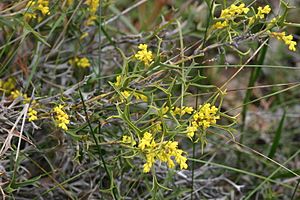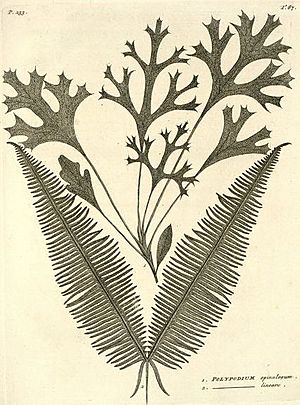Synaphea spinulosa facts for kids
Quick facts for kids Synaphea spinulosa |
|
|---|---|
 |
|
| S. spinulosa subsp. spinulosa | |
| Scientific classification | |
| Genus: |
Synaphea
|
| Species: |
spinulosa
|
| Subspecies | |
|
S. spinulosa subsp. borealis |
|
Synaphea spinulosa is a type of small shrub that belongs to the flowering plant family called Proteaceae. It grows only in Western Australia, meaning it's an endemic species there. This plant, along with another one called Acacia truncata, was one of the very first Australian plants to be officially described and named by scientists. The actual plant sample used for this description is the oldest known Australian plant specimen still existing today! It's likely one of the first Australian plant samples ever collected.
Contents
What Synaphea spinulosa Looks Like
Synaphea spinulosa grows as a small bush, reaching up to about 50 cm (20 inches) tall. Its leaves are quite special. They are deeply split into three main parts, and each of those parts is usually split into three more sections. The very tips of these sections are often triangular and can even have up to three sharp points.
The leaves are not flat; instead, they curve inwards, like a shallow bowl. Overall, the leaves are about 2 to 7 cm (0.8 to 2.8 inches) long and 3 to 7 cm (1.2 to 2.8 inches) wide. They grow on a short stem called a petiole, which is about 0.5 to 2 cm (0.2 to 0.8 inches) long.
This plant produces bright yellow flowers. These flowers grow closely together in spikes that are 2 to 5 cm (0.8 to 2 inches) long. These flower spikes grow on a branched stem called a peduncle, which comes from the upper parts of the plant's branches.
How Scientists Named Synaphea spinulosa
This plant has a very interesting history in the world of botany (the study of plants). It holds several "firsts" for Australian plants! As mentioned, it was one of the first Australian plants to be officially described by scientists. The plant sample used for this description is the oldest known Australian plant specimen that still exists. It might even be one of the very first Australian plant samples ever collected.
Early Discoveries and Naming
We don't know much about when or how the very first sample of Synaphea spinulosa was collected. We only know it had to be before 1768, when the plant was first described. Before that time, the only known visit by Europeans to an area where S. spinulosa grows was by a Dutch sailor named Willem de Vlamingh. He explored Rottnest Island and the Swan River in Western Australia in late 1696 and early 1697.
It's very likely, though not completely proven, that the plant sample was collected during Vlamingh's trip. If so, this would make it older than the oldest confirmed collection of Australian plants, which was done by William Dampier in 1699. We know that a Dutch botanist named Nicolaas Witsen asked Vlamingh to collect plants for him. Records show that Vlamingh returned to Holland with plants, fruits, and wood samples. However, some experts believe that at least one of the two plant samples came from a botanic garden in Java, where a person named Christiaan Kleijnhoff had set up a garden. This is also where Burman said S. spinulosa came from.
In 1768, a Dutch botanist named Nicolaas Laurens Burman got hold of two plant samples. He then published their names, descriptions, and drawings in his book, Flora Indica. S. spinulosa was mistakenly identified as a fern from Java and was named Polypodium spinulosum. The other plant, A. truncata, was also wrongly identified. The sample of A. truncata is now lost, but the sample of S. spinulosa still exists. It is kept at the Herbarium in Geneva, Switzerland. It is one of the oldest plant samples of an Australian native species that we still have today. (Some even older samples collected by William Dampier, like Swainsona formosa, still exist in Oxford, but they weren't described at the time.)
The next known collection of S. spinulosa happened in December 1801. This was when HMS Investigator visited King George Sound under the command of Matthew Flinders. On board were the famous botanist Robert Brown, a plant artist named Ferdinand Bauer, and a gardener named Peter Good. All three collected plant material for Brown's collection, including samples of S. spinulosa. One of Brown's sample tags is dated "Decr 19 1801".
However, Robert Brown didn't realize that this plant was a unique species. In his collection, he labeled S. spinulosa samples as S. polymorpha. Later, when he published his work on the plant group Proteaceae in 1810, he mistakenly put Burman's Polypodium spinulosum under the name S. petiolaris.
In 1919, an American botanist named Elmer Drew Merrill figured out that Burman's Polypodium spinulosum was actually the same plant as S. polymorpha. Because Burman's name was published first, Merrill changed the name of P. spinulosum to S. spinulosa within the Synaphea group. For many years, S. polymorpha was still commonly used, even though S. spinulosa was the correct scientific name. The plant was finally recognized as its own distinct species in 1995 by Alex George. He divided S. polymorpha into several different species for the Flora of Australia book series.
Different Types of Synaphea spinulosa
Scientists have identified three different types, or subspecies, of Synaphea spinulosa:
- S. spinulosa subsp. major has longer flowers than the other types.
- S. spinulosa subsp. borealis has shorter flowers than S. spinulosa subsp. major. Its fruit is smaller, and it has less hair than S. spinulosa subsp. spinulosa.
- S. spinulosa subsp. spinulosa also has shorter flowers than S. spinulosa subsp. major. However, its fruit is larger, and it has more hair than S. spinulosa subsp. major.
Scientists have noted that this plant can look very different from one place to another, and there are still many plant samples that need to be studied to understand all its variations.
Where Synaphea spinulosa Grows
This plant is found only in Western Australia. It is very common throughout the Southwest Botanic Province, which is a special area known for its unique plants. You will almost never find Synaphea spinulosa growing outside of this region.


